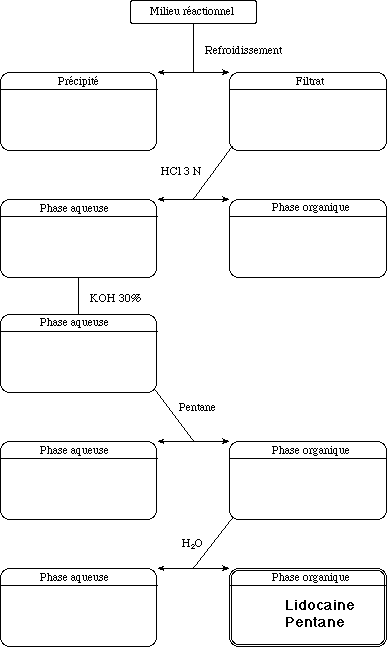
Prénom: ........................
Sart-Tilman, le 29 novembre 1996
Chimie Organique
Interrogation de Travaux Pratiques
Synthesis of Lidocaine: a Local Anesthetic

In a 100-mL round-bottomed flask place a-chloro-2,6-dimethylacetanilide (3) and 45 mL of toluene, then add two moles of diethylamine per mole of 3. Fit the flask with a reflux condenser, add a boiling stone, and reflux vigorously. The progress of the reaction can be measured conveniently at 15- to 30-minute intervals by TLC on silica gel, using chloroform as eluent. After the starting material is practically gone (TLC), cool the mixture and filter out the crystals, rinse them with a small amount of pentane, air dry, and weigh.
Transfer the filtrate to a separatory funnel and extract with two 25-mL portions of 3 N HCl. Cool the acidic aqueous layer in an erlenmeyer flask and add 30 per-cent aqueous KOH until the solution is strongly basic. Extract with 20 mL of pentane. Rinse the pentane layer with six 10-mL portions of water, dry over K2CO3, and concentrate in a 125-mL erlenmeyer flask to an oil. Crystallize the product by cooling in an ice-salt bath. The lidocaine (4) can be isolated at this point by rapid filtration, or it can be converted to the hydrogenosulfate salt.
To convert the base to its salt, dissolve the lidocaine (4) in ether (10 mL per gram of lidocaine) and add 7.1 mL of 0.6 M sulfuric acid in ethanol per gram of lidocaine. Upon stirring a solid should appear within a few minutes. Dilute the mixture with an equal volume of acetone to aid filtration and collect the salt in a small Büchner funnel. Rinse the solid on the funnel with a few mL of acetone, air dry, and weigh the crude product. Recrystallize the salt by dissolving it in an equal weight of hot water and adding, in one portion, 20 times this volume of acetone. Mix well and let stand to crystallize. Collect the crystals, rinsing with acetone, air dry, weigh, and determine the percentage yield and melting point of the product.
Thème I. L'a-chloro-2,6-dimethylacetanilide (3) peut aisément être préparé en deux étapes à partir de 2,6-dimethylnitrobenzène (1) selon le schéma ci-dessous:

1) Proposez un réactif pour la transformation de (1) en (2).
![]()
2) Proposez un réactif pour la transformation de (2) en (3).
![]()
Thème II. Le cours de la réaction de synthèse de la lidocaine est suivi par TLC:
3) Que signifie cet acronyme anglais?
![]()
4) Quelle est sa traduction française?
![]()
5) Décrivez succintement la procédure expérimentale à suivre pour déterminer le terme de la réaction.

Thème III. Séparation et purification de la lidocaine:
6) Complétez le diagramme suivant en indiquant la composition en matières organiques et inorganiques des diverses phases.

7) Justifiez le choix de K2CO3 comme agent desséchant.

Thème IV. Préparation de l'hydrogénosulfate de la lidocaine:
8) Les mesures de volume servant à la préparation et à l'addition d'acide sulfurique dilué doivent-elles être effectuées avec précision ou peuvent-elles être approximatives? Justifiez votre réponse.

9) Comment pourriez-vous amorcer la cristallisation de l'hydrogénosulfate de lidocaine si celle-ci ne se produisait pas spontanément après quelques minutes?

Retour au sommaire des interrogations Retour au sommaire de /licence/